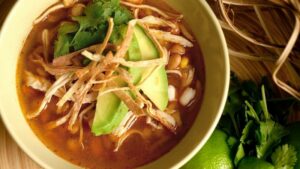Tacos, burritos, nachos – Mexican food is undoubtedly delicious. But it also has a reputation for causing unwanted trips to the bathroom. If you’ve ever wondered why enjoying Mexican cuisine often leads to diarrhea or loose stools, you’re not alone.
There are a few key reasons Mexican fare can wreak havoc on your digestive system:
- Spicy ingredients like hot peppers, chili powder, and cumin can irritate the digestive tract. Capsaicin and other compounds signal your intestines to move food faster, resulting in diarrhea.
- Greasy fried foods like churros and taquitos are hard to properly digest. Excess fat pulls fluid into the colon, causing loose stools.
- Beans, dairy, and other ingredients are common triggers for food sensitivities and intolerances.
- Raw or undercooked ingredients may contain harmful bacteria, viruses or parasites that cause food poisoning.
- Poor food handling practices can cause cross-contamination of ingredients with pathogens.
In most cases, it’s not the Mexican food itself that causes issues – it’s contamination, intolerance to certain ingredients, or eating very spicy or fatty fare that overwhelms the digestive system.
The good news is that with some simple modifications, you can still enjoy delicious Mexican cuisine without the unwanted bathroom effects! In this article, we’ll explore the common culprits behind Mexican food and diarrhea, and give you tips to prevent disasters. Let’s taco ’bout it!
Common Mexican Food Ingredients That Cause Diarrhea
Certain ingredients commonly used in Mexican cooking can trigger diarrhea in sensitive stomachs:
Beans
Beans like pinto, black, and refried are used in many Mexican dishes. Just 1/2 cup of beans packs a whopping 8-10 grams of fiber. This insoluble fiber adds bulk to your stool and speeds up digestion, often causing loose stools.
Dairy Products
Cheese, crema, sour cream, and milk feature heavily in Mexican fare. If you’re lactose intolerant, these dairy products cause diarrhea since your body lacks the enzymes needed to properly digest them.
Hot Peppers
Peppers like jalapeños, habaneros, and chipotles contain capsaicin, which stimulates your digestive tract. Too much of this
Raw Vegetables
Mexican foods like homemade salsa and guacamole incorporate raw veggies. These uncooked ingredients may harbor harmful bacteria, viruses or parasites that can cause food poisoning and urgent bowel movements.
Spices
Heavy doses of spices like chili powder, cumin, and garlic powder speed up digestion, which can equal a quick trip to the bathroom.
Spicy and Fatty Foods
Two trademark components of Mexican cuisine—spice and fat—are common culprits behind diarrhea:
Irritating Spicy Dishes
Spicy salsas, enchilada sauces, chili con carne and other fiery foods irritate your digestive tract. This triggers increased movement of food through your intestines, resulting in loose stools or diarrhea.
Capsaicin and other compounds in hot peppers, chili powder and cumin signal your body to secrete more fluids into your intestines to try to flush out the irritants.
High-Fat Fried Foods
Greasy foods like chilaquiles, taquitos, and churros are hard to digest. Your small intestine has trouble properly breaking down all that fat.
Excess fat in your intestines pulls fluid into your colon in an attempt to dilute and flush it out. This leads to loose, urgent bowel movements.
Poor Food Safety Practices
Like any cuisine, food poisoning is a risk if Mexican food prep doesn’t follow proper safety:
Undercooked Meat
Meats are often cooked at high temps for Mexican dishes like tacos al pastor, carne asada, chorizo, and albondigas soup. If undercooked, raw meat can contain E. coli, Salmonella and other bacteria that cause vomiting, stomach cramps, and diarrhea.
Cross-Contamination
When ingredients for multiple Mexican dishes are prepped together in the same space, bacteria can spread from one food to another. For example, cutting raw meat on a surface and then slicing veggies on the same surface without disinfecting can contaminate the produce. Consuming cross-contaminated food leads to food poisoning.
Improper Holding Temps
Mexican fare like shredded pork, refried beans, and salsas are prone to bacterial growth if not held at proper temperatures. Lettuce, tomatoes, cheese and other ingredients can also spoil if not refrigerated correctly. Consuming foods left in the danger zone of 40-140°F allows pathogens to thrive.
Poor Personal Hygiene
Food handlers that don’t wash hands properly or use unsanitary practices when prepping Mexican dishes are another contamination risk. Many pathogens that cause diarrhea can be transmitted directly from people to food.
Alcohol Consumption
It’s common to enjoy Mexican food with margaritas, beer, or other alcoholic drinks. But alcohol can worsen diarrhea in several ways:
Dehydration
Alcohol acts as a diuretic, causing you to lose more fluids than you take in. This dehydration makes diarrhea worse by further depleting your body’s water and electrolyte levels.
Digestive Slowdown
Booze inhibits the muscle contractions that move food through your intestines. This slowdown allows more time for excess water to enter the colon, resulting in loose stools.
Irritation
Alcohol directly irritates your digestive tract, causing inflammation. This makes your intestines more sensitive and prone to reactivity from spicy foods or other triggers.
Tips to Prevent Diarrhea from Mexican Food
Luckily, there are ways to prevent bathroom emergencies when eating Mexican:
- Request corn instead of flour tortillas if sensitive to gluten
- Choose cheese-less options if lactose intolerant
- Opt for rice over beans as a side dish
- Ask for tomato-based salsas rather than raw, spicy versions
- Avoid ceviche, rare meats, and unpasteurized items
- Limit greasy, fried menu choices like churros and taquitos
- Skip the margaritas, beer, or other alcoholic drinks
- Inspect restaurant cleanliness and hygiene practices
- Ensure meats are fully cooked and dishes made fresh
- Drink bottled water and avoid ice cubes in sensitive regions
Choosing Safer Mexican Menu Options
With some adjustments, you can enjoy Mexican food without digestive distress:
Mains
- Grilled fish, chicken, or steak tacos
- Veggie fajitas with mild tomato-based salsa
- Shrimp quesadillas made with corn tortillas
Sides
- Fresh tomato salsa, pico de gallo, or guacamole
- Cilantro lime rice or cauliflower rice
- Small portion of black or pinto beans
- Roasted veggie skewers
Drinks
- Sparkling water with lime instead of margaritas
- Mexican aguas frescas made with boiled water
- Bottled water and sodas in sealed bottles/cans
Desserts
- Fresh cut fruit cups with cinnamon
- Low-fat Mexican yogurt or kefir
- Sorbet or fruit popsicles made with purified water
When to See a Doctor
In most cases, diarrhea will resolve on its own in 24-48 hours. However, see a doctor right away if you experience:
- Diarrhea lasting more than 3 days
- Intense abdominal pain or cramping
- Blood or mucus in stool
- Fever over 101°F
- Signs of dehydration like dizziness, dry mouth, or dark urine
Severe diarrhea can lead to dehydration and electrolyte imbalance, especially in babies, older adults, and those with compromised immune systems. If you recently traveled to Mexico, also tell your doctor, as bacterial infections like traveler’s diarrhea are common.
Enjoy Mexican Cuisine Without the Bathroom Blues
With some minor adjustments like choosing milder salsas, avoiding greasy fried foods, and watching alcohol intake, you can savor Mexican food without digestive distress. Stick to fresh, high-quality ingredients prepared cleanly and safely. And don’t be afraid to make special requests to accommodate your dietary needs! A few tweaks can let you enjoy all the delicious flavors south of the border—without the unwanted side effects.





